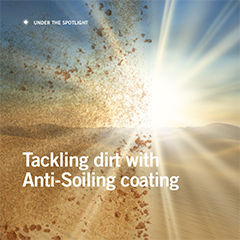Panel soiling has been a running concern for solar park owners since the birth of the solar/PV industry. With many parks located in dry soiling environments, dirt accumulating on solar panels can be a major drain on efficiency, limiting power output and driving up cleaning and maintenance costs. DSM’s new Anti-Soiling coating offers a compelling answer to this widespread industry problem.
Powering up output, panel by panel
A multidisciplinary team of scientists and application technologists from DSM spent three years developing the Anti-Soiling coating solution before it was ready to be brought to market. The coating is an offspring of the company’s patented Anti-Reflective (AR) coating, which has been available on the market for seven years and is now in use at more than 50GW of installations globally.
A series of indoor and outdoor validation tests were carried out as part of the R&D process. These included a controlled, climate-representative test, which was undertaken at a TÜV SÜD solar park in the Gobi Desert, in Dunhuang, China. During the assessment, modules coated with DSM’s Anti-Soiling coating were benchmarked against panels coated with DSM’s Anti-Reflective (AR) coating, as well as non-coated modules, over an 18-month period.
During this time, the DSM team spent 12 months actively measuring the power output of each set of modules to gauge any differences in performance. Each of the panels was manually cleaned a total of 17 times over the course of the testing period, using the exact same cleaning method at precisely the same time on each occasion. The team then tested for module performance using highly accurate monitoring equipment at string level.
The positive results of the assessments were plain to see: under these tightly controlled and representative test conditions, the panels coated with the Anti-Soiling coating delivered 1.1% more power on average compared to panels that integrated DSM’s Anti-Reflective coating [see figure]. On an annual basis, this is more than 17 kWh/kWp more energy gained. This clear outcome underlines both the reliability and added value of the Anti-Soiling coating to solar park owners.
Meaner clean, leaner costs
The cleaning of solar modules represents a major investment by solar park operators, particularly in larger parks where tens of thousands of panels may be in use. In the desert and other challenging environments with dust and dirt, the number of manhours used in manually cleaning modules can be considerable, with numerous intensive cleaning cycles typically required over the course of a year. As well as time, a huge amount of (scarce) water, cleaning products and other consumables typically feed into the process, increasing the overall cost to park owners.
Therefore, as well as reducing the dirt accumulation tendencies of the panels through its coating, a key objective of DSM was to deliver a coating that enabled better cleanability of PV panels. This would mean an easier, faster and less consumable-intensive clean for every cycle.
Again, the validation process at Dunhuang for the Anti-Soiling coating revealed the clear advantages, showing that the Anti-Soiling solution enables easier and faster cleaning of each module and allows reduced use of water and other consumables. The residual soiling level after cleaning is also noticeably reduced. What’s more, as part of the assessment process, robot-cleaning capabilities were tested on Anti-Soiling-coated panels and were approved by two independent equipment producers.



























